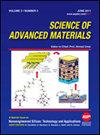Feasibility Analysis of Brain Perfusion Using Polyaspartic Acid Surface-Modified Superparamagnetic Contrast Agent
IF 0.9
4区 材料科学
引用次数: 0
Abstract
This research was aimed to construct polyaspartic acid (PASP) surface-modified magnetic resonance imaging (MRI) contrast agent nanoparticles (NPs) and preliminarily demonstrate the feasibility of using the NPs for MRI cerebral perfusion. Ultrasmall superparamagnetic iron oxide (USPIO) NPs were fabricated by a one-step chemical coprecipitation methodology, and surface modification of USPIO NPs was performed using PASP as the surface modifier to prepare PASP-USPIO NPs. The physicochemical properties of the NPs were detected, and their specific structural ability with HUVECs was visualized by Prussian blue staining. With the contrast agent gadolinium-diethylene triamine pentaacetate (Gd-DTPA) as the control group, the intravenous bolus of USPIO and PASP-USPIO was analyzed and a brain MRI scan of New Zealand white rabbits was performed. The relative cerebral blood volume (rCBV) and maximum signal reduction ratio (SRR max ) values of cerebral gray matter and white matter were calculated based on the plotted time-signal intensity. The results showed that the USPIO and PASP-USPIO NPs were successfully prepared. The average particle sizes were 40.1±5.5 nm and 42.7±6.9 nm, respectively, and the specific saturation magnetization was 86.9 A m 2 ·kg −1 and 51.3 A m 2 ·kg −1 , respectively. Relative to USPIO, human umbilical vein endothelial cells (HUVECs) stained with Prussian blue positively in vitro in the PASP-USPIO group were notably increased, while the rate of change in the signal-to-noise ratio of imaging in vivo was substantially decreased. The time-signal intensity curves were plotted, and it was found that the rCBV of gray matter, rCBV of white matter, SRR max of gray matter, and SRR max of white matter in the USPIO group and PASP-USPIO group were greatly increased relative to control group ( P < 0.05), while the SRR max ratio of gray matter to white matter was decreased ( P < 0.05). Additionally, the rCBV in the gray matter and rCBV in the white matter of the PASP-USPIO group were drastically increased in contrast to the USPIO group ( P < 0.05). In short, the constructed PASP surface-modified USPIO NPs can become a novel MRI contrast agent for monitoring hemodynamic changes in brain tissue.聚天冬氨酸表面改性超顺磁造影剂脑灌注的可行性分析
本研究旨在构建聚天冬氨酸(PASP)表面修饰磁共振成像(MRI)造影剂纳米颗粒(NPs),并初步论证其用于MRI脑灌注的可行性。采用一步化学共沉淀法制备了超顺磁氧化铁(USPIO)纳米粒子,并以PASP为表面改性剂对USPIO纳米粒子进行表面改性,制备了PASP-USPIO纳米粒子。检测NPs的理化性质,并通过普鲁士蓝染色观察其与HUVECs的特异性结构能力。以造影剂钆-五乙酸二乙烯三胺(Gd-DTPA)为对照组,分析静脉注射USPIO和PASP-USPIO,并对新西兰大白兔进行脑MRI扫描。根据绘制的时间信号强度计算脑灰质和白质的相对脑血容量(rCBV)和最大信号减少比(SRR max)值。结果表明,成功制备了USPIO和PASP-USPIO NPs。平均粒径分别为40.1±5.5 nm和42.7±6.9 nm,比饱和磁化强度分别为86.9 A m2·kg - 1和51.3 A m2·kg - 1。与USPIO相比,PASP-USPIO组体外普鲁士蓝阳性染色的人脐静脉内皮细胞(HUVECs)明显增加,而体内成像信噪比变化率明显降低。绘制时间-信号强度曲线,发现USPIO组和PASP-USPIO组脑灰质rCBV、脑白质rCBV、脑灰质SRR max、脑白质SRR max均较对照组显著升高(P <0.05),而脑灰质与脑白质的SRR max比值降低(P <0.05)。此外,与USPIO组相比,PASP-USPIO组的灰质rCBV和白质rCBV显著增加(P <0.05)。总之,构建的PASP表面修饰的USPIO NPs可以成为监测脑组织血流动力学变化的新型MRI造影剂。
本文章由计算机程序翻译,如有差异,请以英文原文为准。
求助全文
约1分钟内获得全文
求助全文
来源期刊

Science of Advanced Materials
NANOSCIENCE & NANOTECHNOLOGY-MATERIALS SCIENCE, MULTIDISCIPLINARY
自引率
11.10%
发文量
98
审稿时长
4.4 months
 求助内容:
求助内容: 应助结果提醒方式:
应助结果提醒方式:


